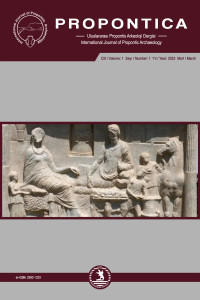Antik Dönemde Triskeles Motifi
Triskeles, Motif, Swastika, Lykia Bölgesi Sikkeleri, Roma.
Triskeles Motif in Antiquity
Triskeles, Motif, Swastika, Lycian Coins, Rome,
___
- Abdel Kader 2012, Abdel Kader, Z. F., “Reflections of Number Symbolism on Egyptian Sacred Architecture”, Engineering Research Journal, 35/3, 265-273.
- Arslan 1999, Arslan, M., “Fethiye Müzesi’ndeki Erken Likya Stater Definesi”, Belleten, LXIII, 1-7.
- Arts and Culture, https://artsandculture.google.com (Accessed: 25.11.2022).
- Babelon 1907, Babelon, E., Traite des Monnaies Grecques et Romanies, Paris.
- Baldwin 1915, Baldwin, A., “Symbolism on Greek Coins”, American Journal of Numismatics, 49, 89-194.
- Barrett 2000, Barrett, D. S., Greek and Roman Coins in the Antiquities Museum of the University of Queensland, Queensland.
- Bulut 2004, Bulut, S., “Erken Dönem Likya Sikkelerinde Triskeles Motifi”, Adalya, VII, 15-68.
- Burillo Cuadrado–Burillo Mozota 2014, Burillo–Cuadrado M. P, Burillo–Mozota F., “The Swastika as Representation of the Sun of Helios and Mithras”, Mediterranean Archaeology and Archaeometry, 14/3, 29-36.
- Büyükkolancı 2013, Büyükkolancı, M., “Adada Antik Kenti ve Geleceği”, Pisidia Araştırmaları-1 Sempozyum Bildiri Kitabı, Isparta 2012, Isparta, 197-214.
- Büyükyörük–Çelik 2019, Büyükyörük F.–Çelik A., “Mithrapata ve Aruwãtijesi (Musa Dağı?) Definesi”, Cedrus, VII, 239-265.
- Cartailhac 1886, Cartailhac, E., Les Ages Prehistoriques de l’Espagne et du Portugal, Paris.
- Childs 1981, Childs, W. A. P., “Lycian Relations with Persians and Greeks in the Fifth and Fourth Centuries Re-examined”, Anatolian Studies, 31, 55-80.
- CNG, Classical Numismatic Group, https://www.cngcoins.com (Accessed: 25.11.2022).
- D’Alviella 1891, D’Alviella, E. G., La Migration des Symboles, Paris.
- Dawson 1999, Dawson, S., “The Athenian Wappenmünzen”, Scholia, 8/1, 71-78.
- De Lisle 2017, De Lisle, C., “The Coinage of Agathokles of Syracuse: Sicilian and Hellenistic Influences”, The Numismatic Chronicle, 177, 9-28.
- Doğan 2012, Doğan, Y., “Dynastik Lykia: Sikkeler Işığında İdari Örgütlenme ve Tarihi Coğrafya”, (Yayımlanmamış Yüksek Lisans Tezi), Akdeniz Üniversitesi Sosyal Bilimler Enstitüsü, Antalya.
- Erhan 2014, Erhan, F., “Antik Çağ Kilikia Sikkelerinde Dinsel Tasvirler”, (Yayımlanmamış Doktora Tezi), İstanbul Üniversitesi Sosyal Bilimler Enstitüsü, İstanbul.
- Erkanal 1975, Erkanal, A., “Dört İnsan Figüründen Oluşan Anafor Bezeği Üzerine Bir Araştırma”, Anadolu/Anatolia, 19, 69-87.
- Filocamo 2016, Filocamo, A., “Ancient and Modern Iconography in the Context of Monetary Alliances”, Journal of Ancient History and Archaeology, 3/4, 50-59.
- Fisher-Bossert 2012, Fisher-Bossert, W., “The Coinage of Sicily”, he Oxford Handbook of Greek and Roman Coinage, 1-15.
- Freed–Freed 1980, Freed, S.A., Freed, R.S., “Swastika: A New Symbolic Interpretation” Rice Institute Pamphlet-Rice University Studies, 66/1, 87-105.
- Gates 2005, Gates, C., “Review Article: Tracking the Achaemenid Persians in Anatolia”, AJA, 109, 789-792.
- Giuseppe Gallo, https://www.giuseppegallo.design (Accessed: 25.11.2022).
- Gutenberg, https://www.gutenberg.org (Accessed: 25.11.2022).
- Herzfeld 1941, Herzfeld, E. E., Iran in the Ancient East: Archaeological Studies Presented in the Lowell Lectures at Boston, London.
- Homeros, Homeros, “Odysseia” (trans. A. Erhat-A. Kadir), İstanbul, 2008.
- Işık 2010, Işık, F., “Anadolu-Lykia Uygarlığı: Lykia’nın Hellenleşmesi Görüşüne Eleştirel Bir Yaklaşım”, Anadolu/ Anatolia, 36, 65-125.
- Kopij 2012, Kopij, K. “Propaganda War over Sicily? Sicily in the Roman Coinage During the Civil War 49-45 BC”, Studies in Ancient Art and Civilization, 16, 167-182.
- Küçükhasköylü 2017, Küçükhasköylü, N., “İngiliz Ressam William James Muller ve Anadolu Seyahati”, Çanakkale Araştırmaları Türk Yıllığı, 15/23, 317-337.
- Moore 2007, Moore, M. B., “The Princeton Painter in New York”, Metropolitan Museum Journal, 42, 21-56.
- Münzkabinett Online Catalogue, https://ikmk.smb.museum/home (Accessed: 25.11.2022).
- Müseler 2018, Müseler, W., “Beyond the Xanthos Valley Rulers and Mints in Eastern and Central Lycia at the Time of the “Dynasty of Xanthos”, Gephyra, 15, 11-27.
- Müseler 2019, Müseler, W., “Opponents and successors of the Xanthian Dynasty in Western Lycia: The Weχssere Questions Reconsidered”, Gephyra, 17, 29-81.
- Noe 1958, Noe, S. P., Coinage of Caulonia, New York.
- Orthmann 1963, Orthmann, W., Die Keramik der Frühen Bronzezeit aus Inneranatolien, Berlin.
- Özsaygı 1996, Özsaygı, M., “Yeni Bulunan Bir Aspendos Definesi”, Arkeoloji Dergisi, IV/222, 1-31.
- Özüdoğru 2007, Özüdoğru, Ş., “Patara and the Dynast Wakhssepddimi (Wekhssere II)”, Adalya, X, 31-48.
- Penelope, https://penelope.uchicago.edu/Thayer/E/Roman/Texts/Strabo/6B*.html (Erişim Tarihi: 25.11.2022).
- Perseus, http://www.perseus.tufts.edu/hopper/ (Accessed: 25.11.2022).
- Philippou 2019, Philippou, C., “Sacred Symbol Part 2: Triump i.e. Triskelion-Triple Spiral (Trispiral) Trinacria-Thrinacia (Thrinacie)-Thrinacis”, Oxford, 1-5.
- Quinn 1994, Quinn, M., “The Swastika: Constructing the Symbol”, London.
- RPC, Roman Provincial Coins, https://rpc.ashmus.ox.ac.uk/ (Accessed: 25.11.2022).
- Sheedy 2014, Sheedy, K., “Sicilian Accessions for Acans: Akragas, Messana, Syracuse and Katane”, Journal of the Numismatic Association of Australia, 25, 80-89.
- Taylor 2016, Taylor, J. E., “Gods, Goddesses and Flying Horses: A History of Coins in Ancient Greece”, The Catalogue of Greek Coins in the British Museum, 1-95.
- Tekin 1991, Tekin, O., “Aspendos Sikkeleri”, (Yayımlanmamış Doktora Tezi), İstanbul Üniversitesi Sosyal Bilimler Enstitüsü, İstanbul.
- Temür 2016, Temür, A., “Yunan Sanatında Karışık Yaratıklar ve Kökenleri Işığında, Doğu Sanatları ile Batı Sanatları Arasındaki Etkileşimler”, Uluslararası Amisos Dergisi, 1(1), 1-15.
- Vahia–Yadav 2010, Vahia, M. N.–Yadav, N., “Harappan Geometry and Symmetry: A study of Geometrical Patterns on Indus Objects”, Indian Journal of History of Science, 45(3), 1-20.
- Vitale 2015, Vitale, M., “Rappresentazioni simboliche della Sicilia sulle monete greche e romane”, ὅρμος-Ricerche di Storia Antica 7, 200-225.
- Voukelatos 2011, Voukelatos, J., “The Triskeles on Ancient Greek Coins”, NomKhron, 29, 7-24.
- Wildwinds, https://www.wildwinds.com (Accessed: 25.11.2022).
- Wilson 1894 Wilson, T., “The Swastika: The Earliest Known Symbol, and its Migrations; with Observations on the Migration of Certain Industries in Prehistoric Times”, National Museum, Toronto.
- Wilson 2000, Wilson, R. J. A., “On the Trail of the Triskeles: from the McDonald Institute to Archaic Greek Sicily”, Cambridge Archaeological Journal, 10(1), 35-61.
- Başlangıç: 2023
- Yayıncı: Ondokuz Mayıs Üniversitesi
Parion İskeletleri Üzerine Osteoarkeolojik Bir Çalışma: 2020-2021 Kazı Sezonu
Mustafa Tolga ÇIRAK, Serhan MUCUR, Nurdan Asiye TÜRKSAL
LAMPSAKOS’UN GEÇ HELLENİSTİK DÖNEM SİKKELERİNE İLİŞKİN YENİ KANITLAR
Antik Dönemde Triskeles Motifi
Knidos’tan Bir Grup Pişmiş Toprak Boğa Figürini
Paphlagonia Bölgesi Roma Eyalet Sikkeleri Üzerindeki Nemesis Tasvirleri
